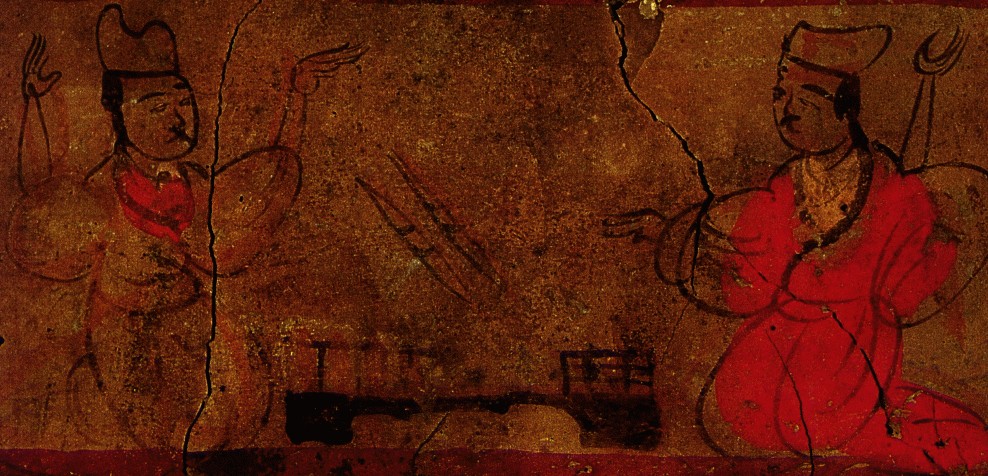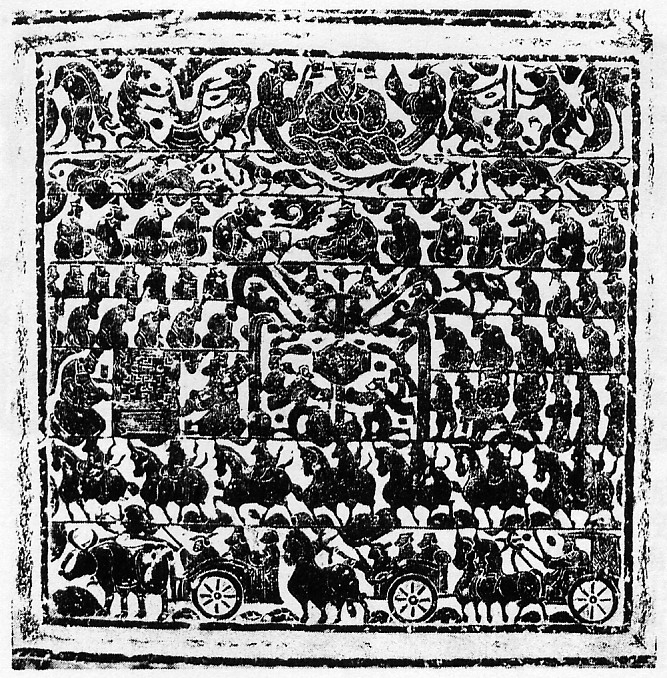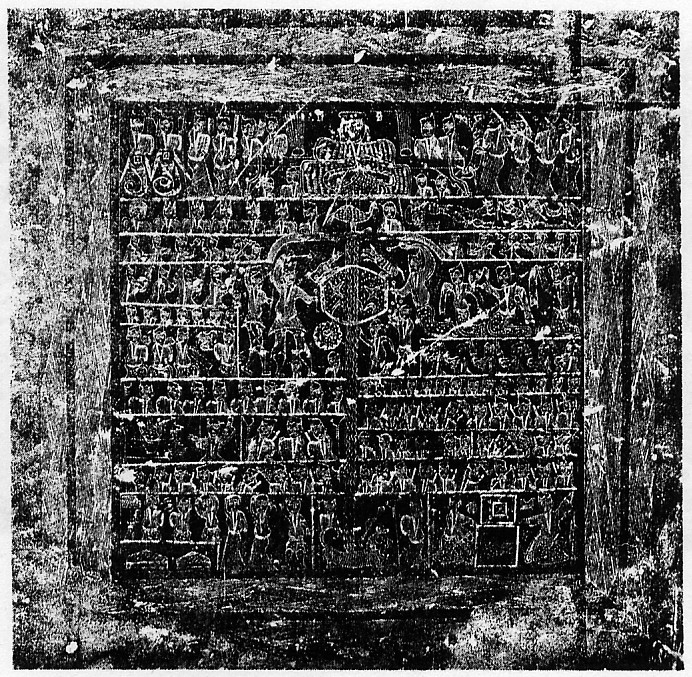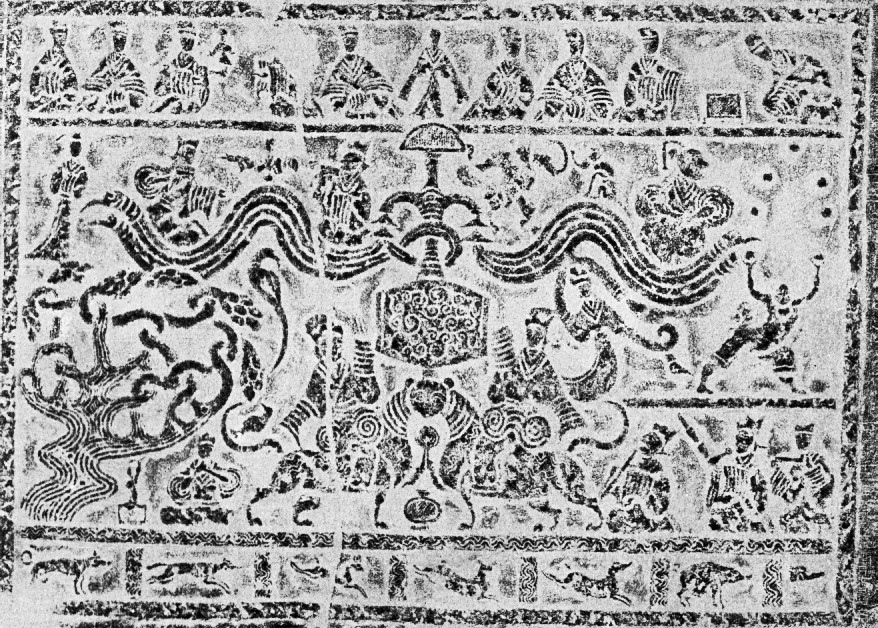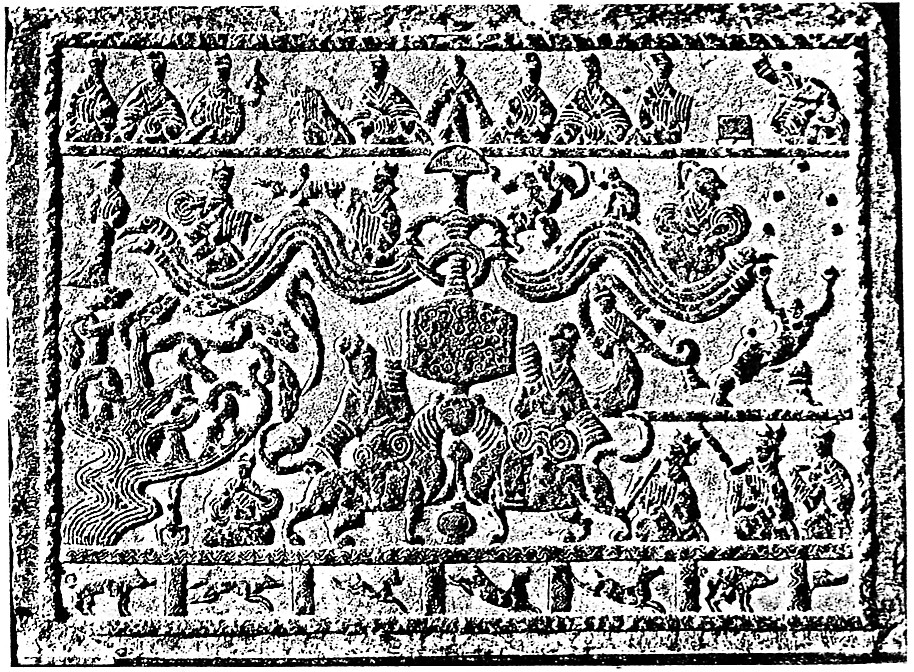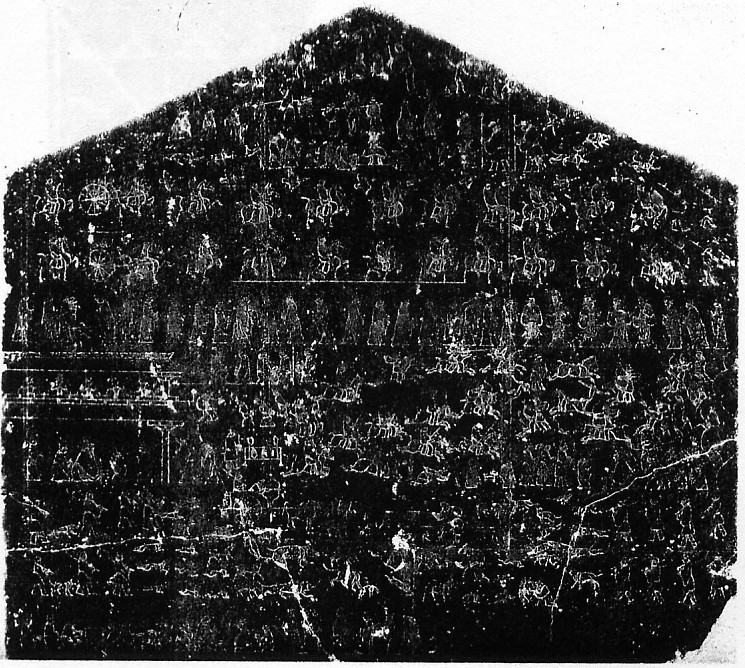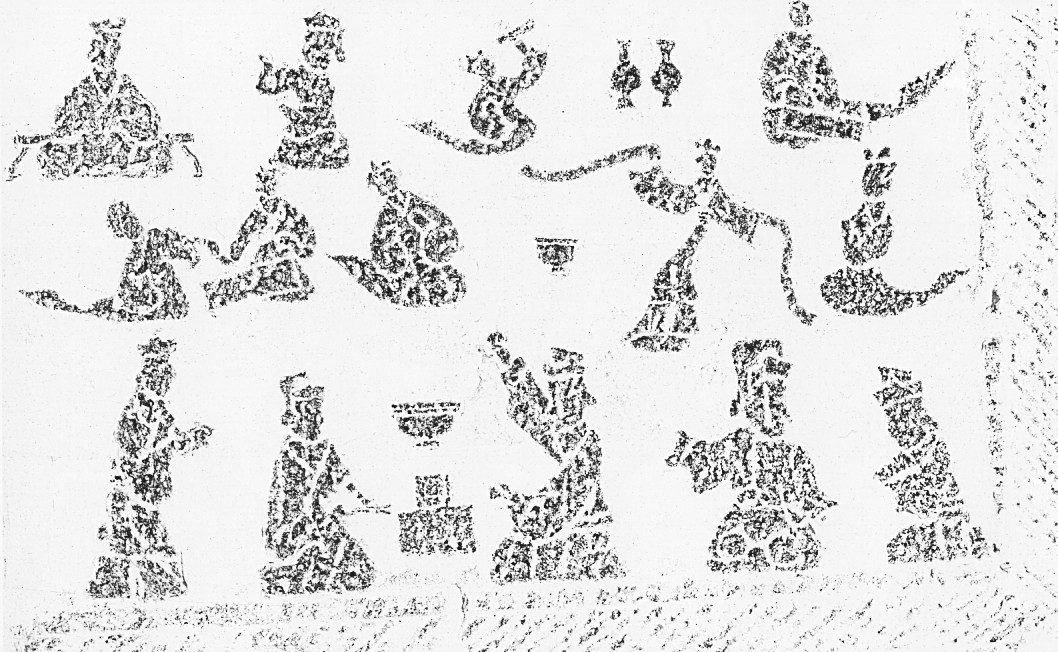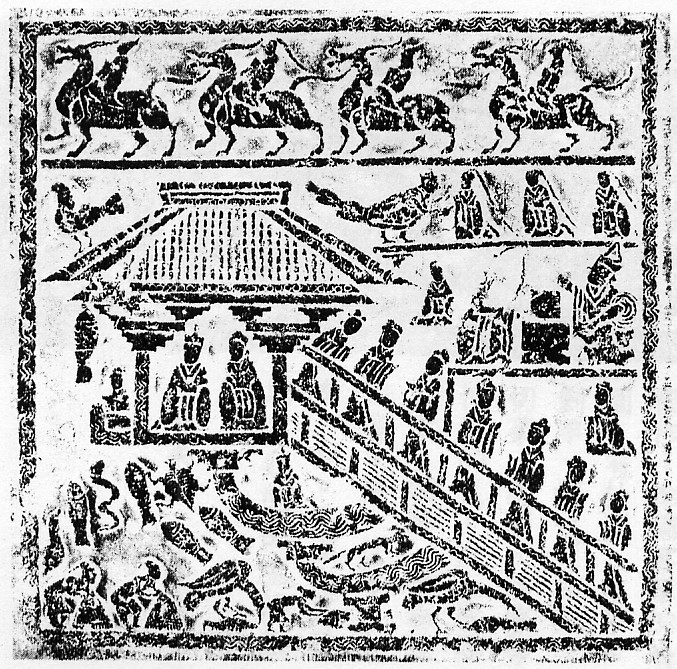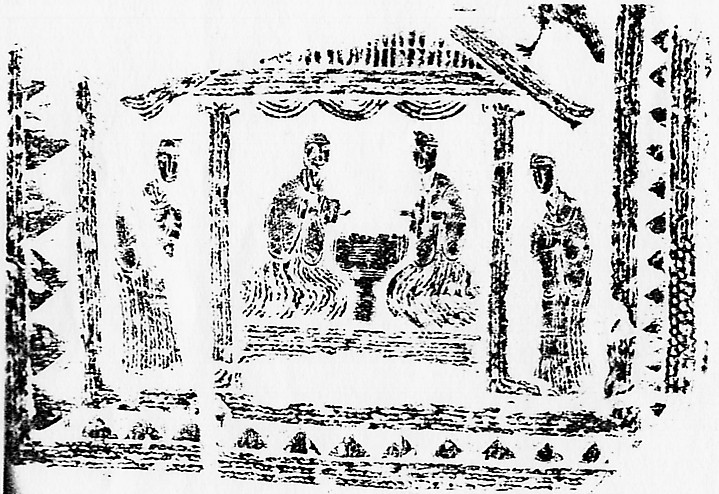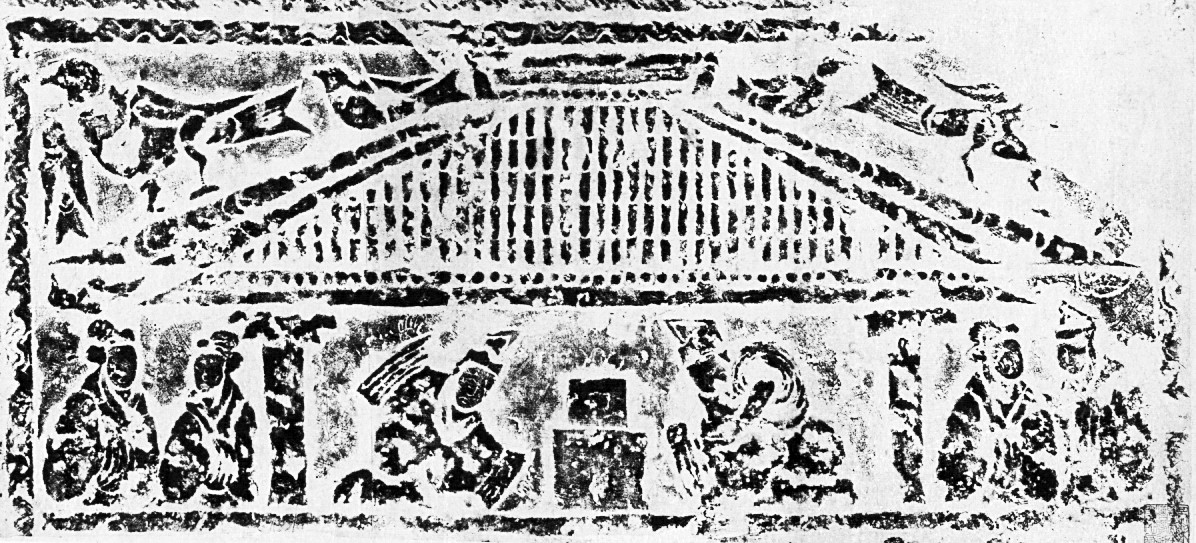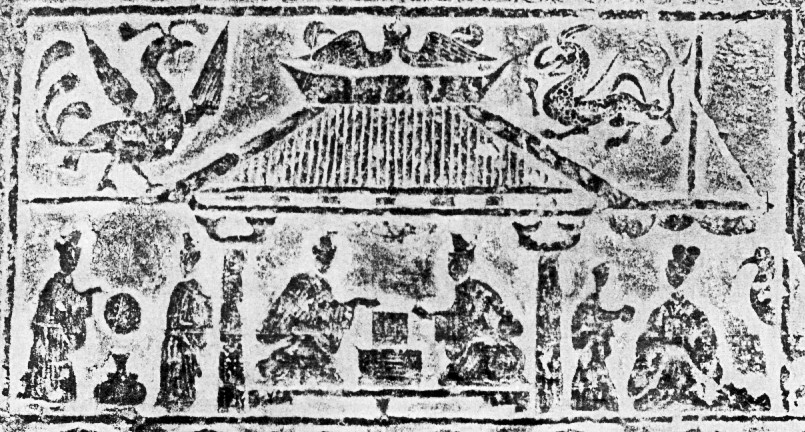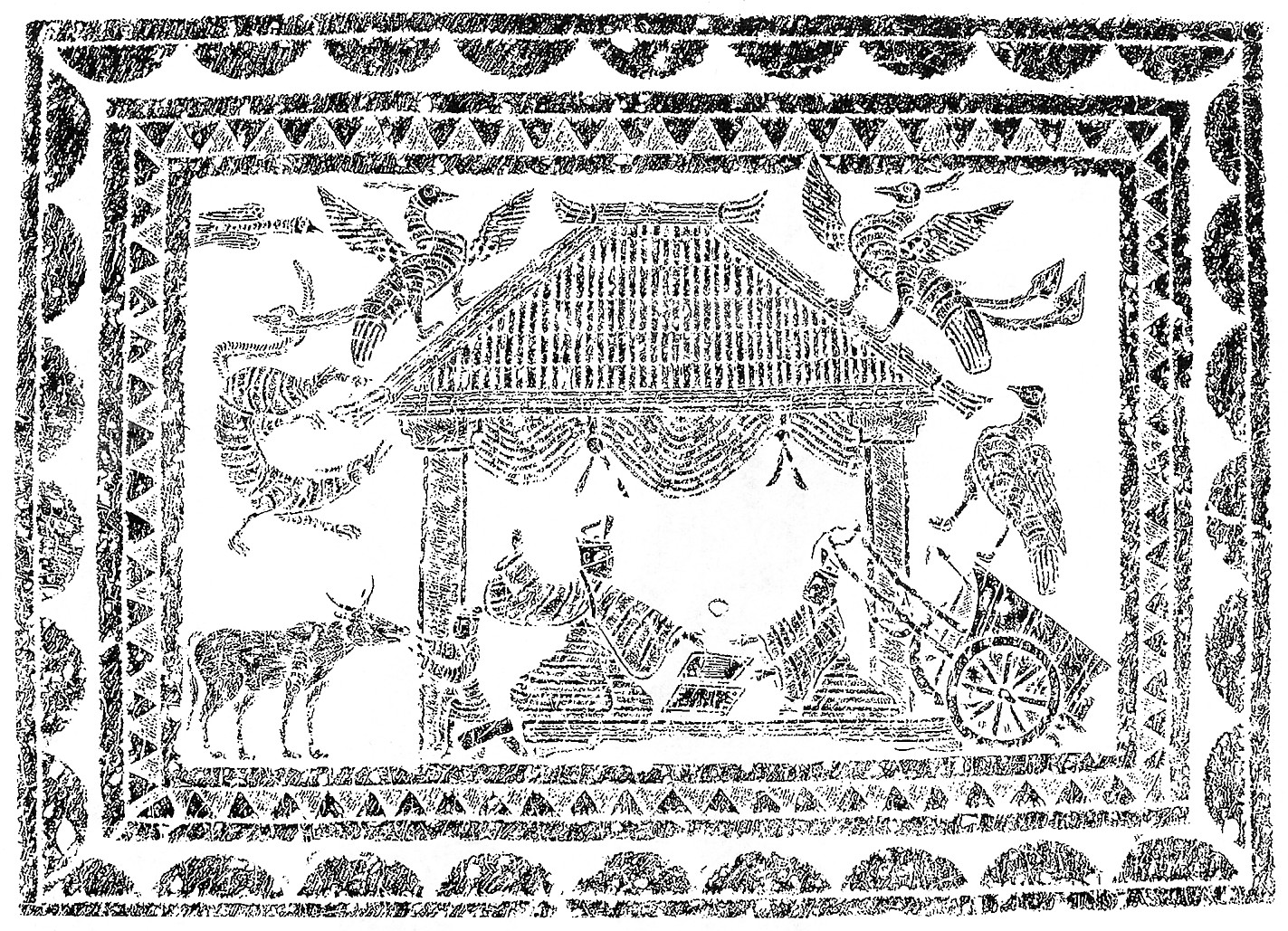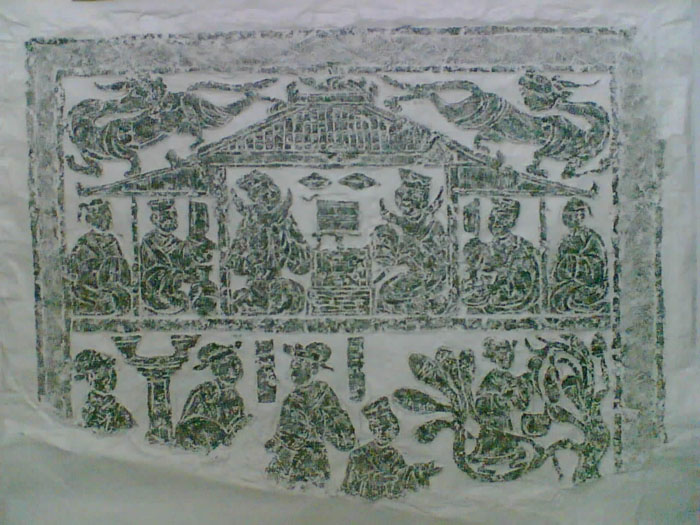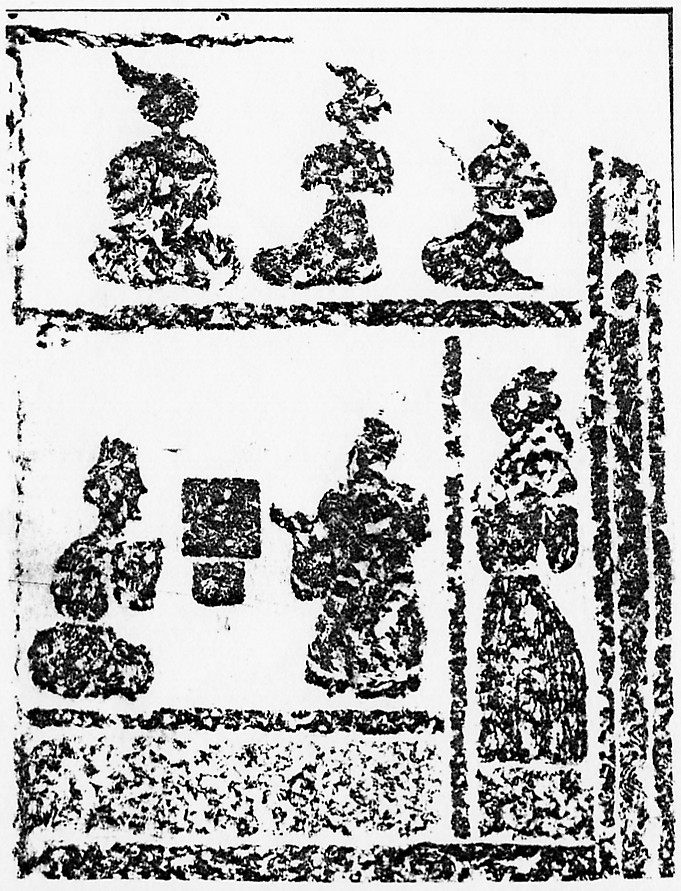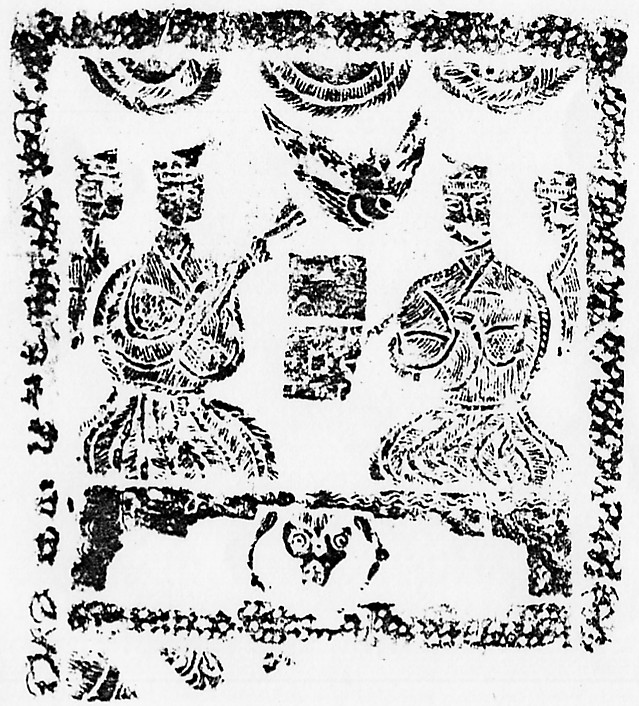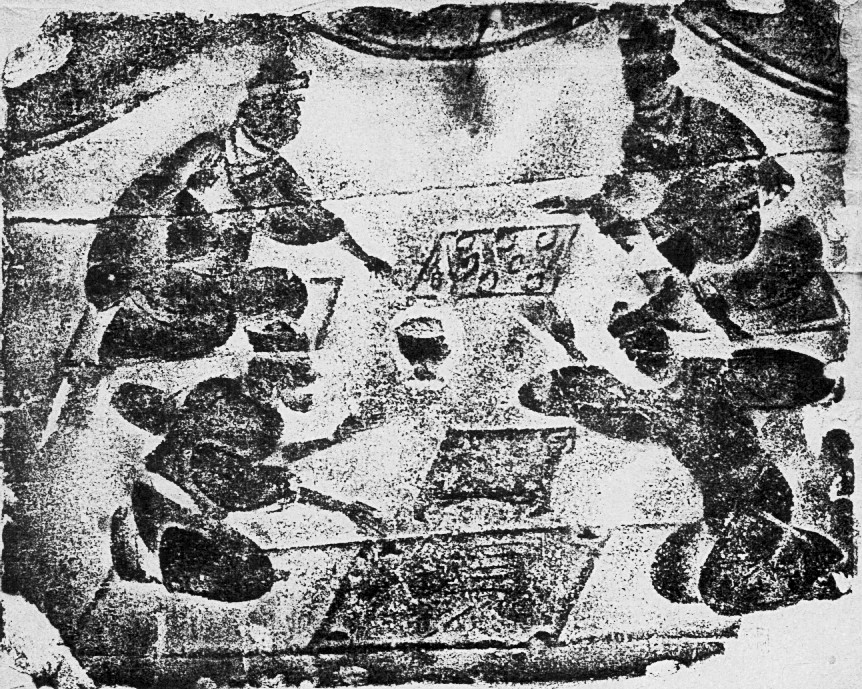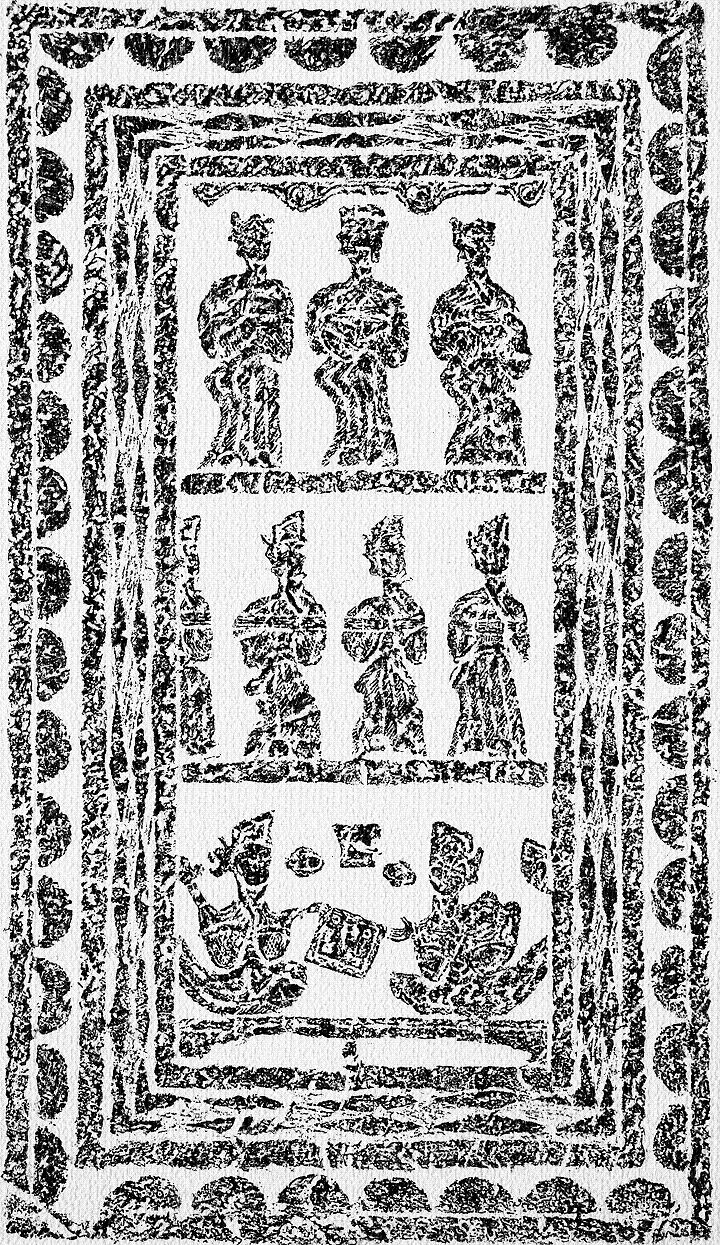BabelStone Blog
Sunday, 12 July 2009
The Lost Game of Liubo Part 2 : Pictures of People playing Liubo
- Part 1 : Funerary Statuettes of Liubo Players
- Part 2 : Pictures of People playing Liubo
- Part 3 : Pictures of Immortals playing Liubo
- Part 4 : Liubo Boards and Game Equipment
- Part 5 : Liubo Divination
- Part 6 : Liubo Patterns on Mirrors and Coins
- Appendix : Eighteen-Sided Dice
As can be seen on this page, there are a great many depictions of Liubo players dating to the Han dynasty, most of them occuring on engraved picture stones (畫像石) or on moulded picture bricks (畫像磚) or on engraved stone coffins. Picture stones and picture bricks were extensively used for decorating tombs and temples during the Han dynasty, especially during the Eastern Han period (25–220), and they depicted almost every conceivable aspect of both the human and mythological realms. They included images of people of all social classes, divine beings, mythological creatures, wild beasts and farm animals, as well as the full range of human life, such as feasting, drinking, dancing, making music, performing acrobatic feats, playing games, hunting, farming, fishing, mining, warring, and even sex. Playing Liubo was obviously seen as a fairly important pastime, as it was regularly portrayed in both scenes of human activity and in scenes of a mythological nature (the latter will be covered separately in the next post in this series). In contrast, there appear to be no known scenes of people playing the game of Go on Han picture stones or picture bricks.
There were three main areas of production and use of picture stones and picture bricks during the Han dynasty : Shandong and Jiangsu in the north, and Sichuan in the south. Each area had its own particular styles and themes; for example many picture stones from Shandong show a mixture of mythological figures and scenes of human activity crammed into large, densely populated panels (see pictures 4A.1 through 4A.7). In these picture stones the Queen Mother of the West (Xiwangmu 西王母) is usually depicted at the top of the picture, together with various mythological creatures and beings that are associated with her (e.g. the snake-bodied incestuous progenitors of humankind, Fuxi and Nüwa; nine-tailed foxes; and hares pounding the elixir of immortality). Below this are shown scenes of banqueting and hunting, with musicians, dancers and acrobats providing entertainment. It may be that the scenes of human activity shown in these pictures were intended to represent life in the heavenly paradise of the Queen Mother of the West. If so, playing Liubo is one of the delights to be looked forward to, as a couple of Liubo players generally seem to sneak their way into some corner of such pictures. As we shall see in the next post, the Queen Mother of the West and her friends are also associated with pictures of "immortals" playing Liubo on engraved stone coffins and picture bricks from Sichuan.
On the other hand, many picture stones and picture bricks appear not to be so concerned with the mythological and the divine, but show realistic depictions of all aspects of life in the human world, with Liubo-playing being one of the mundane activities that is most frequently portrayed, either as part of a larger scene or as the main focus of the picture. In particular picture stones from Jiangsu and Shandong often show a couple of people playing Liubo in the cool of a pavilion, attended to by servants, and with large wine bowl and ladle nearby and/or a wine cup by each player (see pictures 4A.20 through 4A.31). The players usually appear very animated, with their arms extended in gestures of excitement. Clearly the game was far from dull, and the wine that the players drunk whilst playing seems to have frequently resulted in raised tempers, fights and even the occasional death. Sima Qian 司馬遷 records the following violent incidents during the playing of Liubo:
In the autumn of the 11th year (682 BCE) Duke Min of Song went hunting with Nangong Wan, and because they had an argument over a game of Liubo the duke became angry, and insulted Wan, saying "Originally I respected you, but now you are nothing more than a captive of the State of Lu". Wan was strong, and he objected to these words, so he killed the duke at the Marshes of Meng with the game board. Records of the Grand Historian vol.38.
十一年秋,湣公與南宮萬獵,因博,爭行,湣公怒,辱之,曰:「始吾敬若;今若,魯虜也。」萬有力,病此言,遂以局殺湣公於蒙澤。 《史記》卷038.
Jing Ke (died 227 BCE) travelled to Handan, where Lu Goujian played a game of Liubo with him. They had an argument over the game, and Lu Goujian became angry and swore at Jing Ke. Jing Ke fled without saying a word; and he never came back again. Records of the Grand Historian vol.86.
荊軻遊於邯鄲,魯句踐與荊軻博,爭道,魯句踐怒而叱之,荊軻嘿而逃去,遂不復會。 《史記》卷86.
During the reign of Emperor Xiaowen (180–157 BCE), the Prince of Wu (Liu Xian) came to court, and he was able to attend upon the crown prince [the future Emperor Jing of Han], drinking and playing Liubo together. The teachers of the Prince of Wu were all men of the State of Chu, who were rude and arrogant. While playing Liubo the two of them had an argument over the game, and the Prince of Wu was disrespectful; whereupon the crown prince lifted up the game board and threw it at the Prince of Wu, killing him. Records of the Grand Historian vol.106.
孝文時,吳太子入見,得侍皇太子飲博。吳太子師傅皆楚人,輕悍,又素驕,博,爭道,不恭,皇太子引博局提吳太子,殺之。 《史記》卷106.
Interestingly all three incidents use the same formula to express the onset of the argument: "... played Liubo, and fought over the way" ...博,爭道/行... In this context dào 道 and xíng 行 are synonymous, both meaning "way" or "path", and evidently refer to the paths of play on the board (i.e. the TLV lines). This suggests that during the course of the game players would vie for control of a particular "path", but how exactly the path was fought over is not clear. All that is certain is that Liubo was potentially a very dangerous game to play.
One last point of interest is the position of the Liubo board in relationship to the players. In most pictures of Liubo playing, the two players face each other across a mat (or some other surface) onto which the throwing sticks are thrown, with the distinctively marked Liubo board placed to the side of the mat, often apparently out of immediate reach of the players. One of the players is usually shown with arms extended as if in the middle of throwing a throwing stick onto the mat, but no picture shows either of the players (or anyone else) moving pieces around the Liubo board. Furthermore, although the markings of the Liubo board are usually very clearly shown, no game pieces are normally visible on the Liubo board. The artistic focus on the stick-throwing aspect of the game rather than the moving of pieces around the board distinguishes authentic Han depictions of the game from later fantasy reconstructions of Liubo playing such as Wang Hongli's well-known painting:
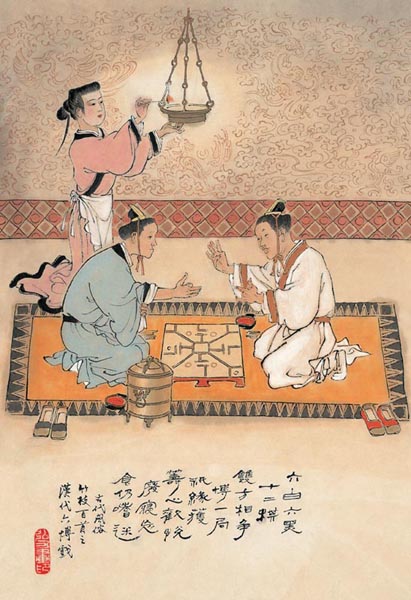
Wang Hongli 王弘力 (1927–2019), 古代風俗百圖 (100 pictures of ancient customs) No.86 : 六博 (Liubo)
3. Paintings of Liubo Players
3.1 Coloured mural from an Eastern Han tomb in Henan
河南洛陽朱村東漢墓彩繪壁畫
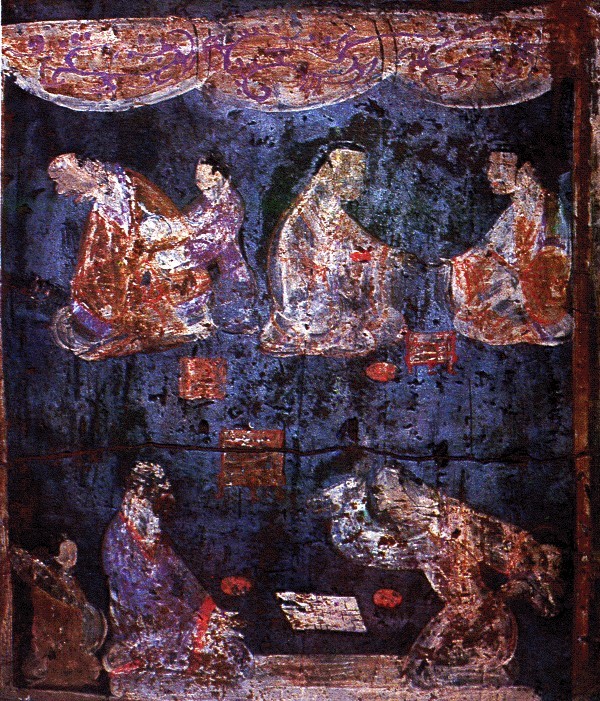
Source : Wenwu 文物 1992.12
Provenance : Tomb at Zhu Village, Luoyang, Henan. {34.460°N 112.477°E}
Current Location : Unknown.
Date : Eastern Han (25 CE – 220 CE).
Size : Unknown.
Notes : The two figures in the foreground are playing Liubo, with the playing mat between them, and the Liubo board to the side of the mat. The two red, circular objects next to the liubo board are probably intended to represent lacquer wine cups. The player on the right is taking his turn, with his right hand raised up as if about to throw down the six throwing sticks.
References : 《洛陽市朱村東漢壁畫墓發掘簡報》 (《文物》1992.12).
3.2 Mural from an Eastern Han tomb in Shaanxi
陝西靖邊楊橋畔村東漢墓壁畫
Source : Wenwu 文物 2009.2 page 38 fig. 25
Provenance : Tomb at Yangqiaopan Village, Jingbian, Shaanxi. {37.615°N 109.0427°E}
Current Location : Unknown.
Date : Eastern Han (25 CE – 220 CE).
Size : Unknown.
Notes : This mural, on the eastern wall of the antechamber, shows several people sitting in front of a screen watching a performance of dancers and acrobats. The three characters on the left side may be engaged in a game of Liubo, although this is far from certain, and in the archaeological report they are described as being involved in a discourse. Liubo players are frequently depicted in association with acrobats and other performers (e.g. 4A.18), and in this mural the white square outline between the two opposing figures may be the throwing mat, and the smaller black square behind it might be the Liubo board.
References : 《陝西靖邊東漢壁畫墓》 (《文物》2009.2).
3.3 Lacquer plate from a Three Kingdoms period tomb from Anhui
安徽省馬鞍山市三國吳朱然墓出土彩繪貴族生活圖漆盤
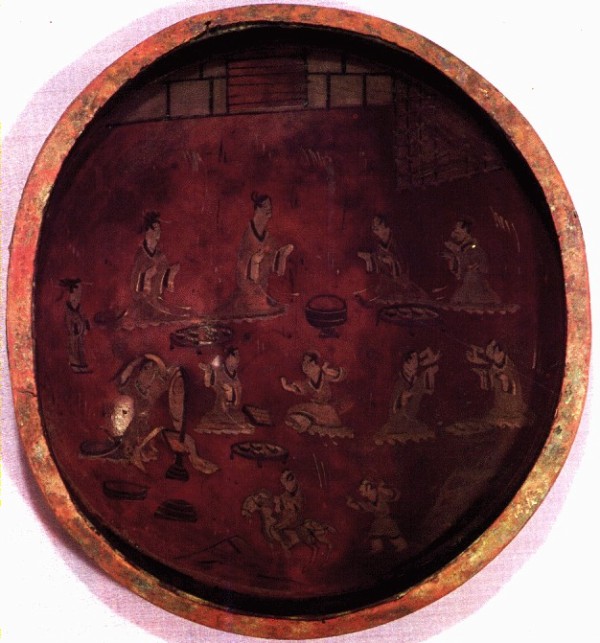
Source : Zhongguo Meishu Quanji 中國美術全集・工藝美術編 (Beijing, 1989) vol.8 plate 68
Provenance : Tomb of Zhu Ran 朱然 at Ma'anshan in Anhui.
Current Location : Anhui Cultural Relics and Archeology Research Institute (安徽省文物考古研究所).
Date : Wu (222–280).
Size : 24.8 cm. in diameter.
Notes : The two figures in the centre of the picture are described as playing Liubo, but I am not certain that they are playing Liubo or any other board game. The object between them might be a game board, but the distinctive Liubo board markings are not evident, and there is no throwing mat next to it (as in almost all Han depictions of the game), so maybe it is something else. And although the "players" are making expressive hand movements, to me they look different to the gestures that are seen on Liubo players on Han picture stones, and it looks to me as if they are dancing rather than playing Liubo. If they are actually playing Liubo, then it is one of the very few examples of post-Han depiction of the game.
3.4 Painted brick from a Three Kingdoms or Jin period tomb in Gansu
甘肅嘉峪關魏晉時期7號墓
Source : Zhongguo Zhongda Kaogu Faxian 中國重大考古發現 (Beijing, 1989) page 177
Provenance : Jiayuguan, Gansu.
Current Location : Unknown.
Date : Wei (220–265) or Jin (265–420).
Size : Unknown.
Notes : This is another possible post-Han depiction of Liubo playing. In this case the two players do seem to be playing a game of some sort, but it is far from certain that it is Liubo that they are playing. The two players are kneeling on either side of a chequered board (a repurposed Go board?), and the player on the left has just thrown two sticks onto the board. However, there is no Liubo board in sight, and the players are using two throwing sticks rather than six, so perhaps it is a later version of Liubo rather than the classic version of the game played during the Han dynasty.
4. Picture Stones and Picture Bricks
4A. Scenes showing Human Liubo Players
4A.1 Eastern Han picture stone from Shandong
山東滕州市西戶口村出土東漢畫像石
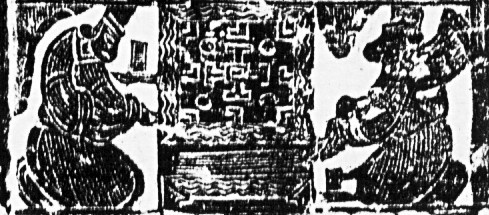
Source : Zhongguo Meishu Quanji 中國美術全集・繪畫編 (Shanghai, 1988) vol.18 plate 32
Provenance : Xihukou Village, Tengzhou, Shandong. {35.085°N 117.324°E}
Current Location : Shandong Provincial Museum (山東省博物館).
Date : Eastern Han (25 CE – 220 CE).
Size : 82.0 × 83.0 cm.
Notes : The top panel shows the Queen Mother of the West, with Fuxi and Nüwa intertwined on either side, two nine-tailed foxes beneath, and two pairs of hares pounding the elixir of immortality. Below the top mythological panel are six panels centred around a large erect double-sided drum. These lower panels depict people engaged in various activities, including a pair of Liubo players on the left side of the third panel from the bottom.
4A.2 Eastern Han picture stone from Shandong
山東滕州市西戶口村出土東漢畫像石
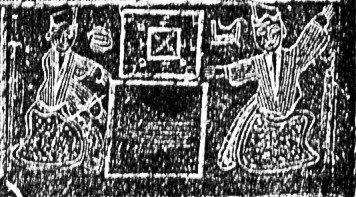
Source : Zhongguo Meishu Quanji 中國美術全集・繪畫編 (Shanghai, 1988) vol.18 plate 33
Provenance : Xihukou Village, Tengzhou, Shandong. {35.085°N 117.324°E}
Current Location : Shanghai Museum (上海博物館).
Date : Eastern Han (25 CE – 220 CE).
Size : 83.0 × 83.0 cm.
Notes : The top panel shows the Queen Mother of the West (labelled as "西王母"), with various mythological figures on either side. Below the top mythological panel are nine panels centred around a large erect double-sided drum. These lower panels depict people engaged in various activities, including a pair of Liubo players on the right of the bottom panel.
4A.3 Eastern Han picture stone
東漢畫像石
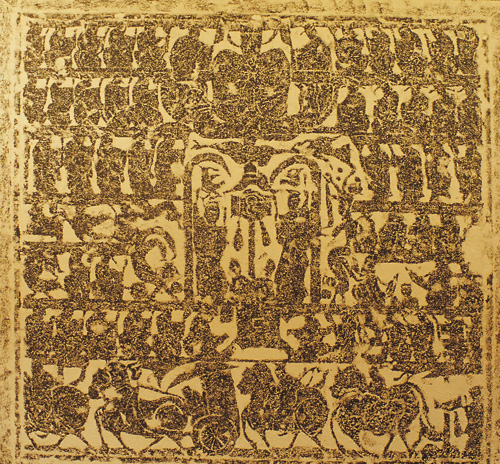
Source : 一曲歌舞潤澤百世
Provenance : Unknown, but probably Shandong.
Current Location : Unknown.
Date : Eastern Han (25 CE – 220 CE).
Size : Unknown.
Notes : The top panel shows the Queen Mother of the West, with Fuxi and Nüwa intertwined on either side. The Liubo players are directly beneath the drum in the middle of the picture.
4A.4a Eastern Han picture stone from Shandong
山東出土戴氏享堂漢永初七年畫像石
Source : Handai Huaxiang Quanji 漢代畫象全集 (Beijing, 1950–1951) vol.1 plate 232
Provenance : Shandong.
Current Location : Unknown.
Date : Eastern Han : Yongchu 7 (113 CE).
Size : Unknown.
Notes : The main panel would appear to show musicians, dancers and acrobats in a heavenly paradise. On the far right of the top panel two people appear to be playing Liubo, although unusually there is a Liubo table between them, but no throwing mat.
4A.4b Eastern Han picture stone from Shandong
山東濟寧兩城山出土東漢畫像石
Source : Zhongguo Diaosushi Tulu 中國雕塑史圖錄 (Shanghai, 1983) vol.1 page 267
Provenance : Liangcheng Shan, Jining, Shandong. {35.158°N 116.738°E}
Current Location : Berlin.
Date : Eastern Han : Yonghe 2 (137 CE).
Size : Unknown.
4A.5 Han Dynasty picture stone from Shandong
山東滕州宏道院出土漢代畫像石
Source : Handai Huaxiang Quanji 漢代畫象全集 (Beijing, 1950–1951) vol.1 plate 91
Provenance : Hongdao Yuan, Tengzhou, Shandong. {35.106°N 117.161°E}
Current Location : Unknown.
Date : Han Dynasty (202 BCE – 220 CE).
Size : Unknown.
4A.6 Eastern Han picture stone from Shandong
山東濟南市長清區孝堂山東漢石祠西壁畫像石

Source : Zhongguo Meishu Quanji 中國美術全集・繪畫編 (Shanghai, 1988) vol.18 plate 56
Provenance : Xiaotang Shan, Jinan, Shandong. {36.399°N 116.602°E}
Current Location : In situ.
Date : Eastern Han (25 CE – 220 CE).
Size : 180.0 × 210.0 cm.
Notes : The top of the picture shows the Queen Mother of the West and associated mythological figures. Below this are battle scenes, apparently between the Chinese and the Xiongnu, as one of the figures is labelled "King of the Barbarians" (胡王). At the bottom left of the picture are Liubo players and people feasting.
4A.7 Han Dynasty picture stone from Shandong
山東嘉祥宋山漢墓出土漢代畫像石
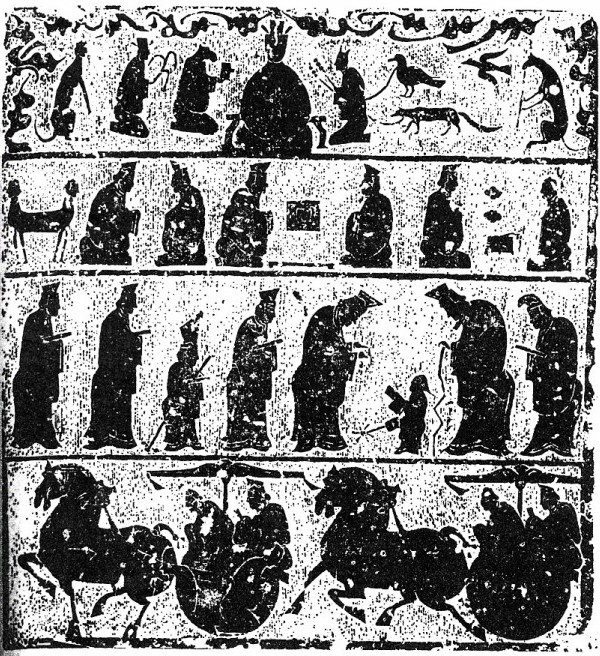
Source : Wenwu 文物 1979.9 page 5
Provenance : Songshan, Jiaxiang, Shandong. {35.195°N 116.287°E}
Current Location : Unknown.
Date : Han Dynasty (202 BCE – 220 CE).
Size : Unknown.
Notes : One of a series of eight stylistically different Han dynasty picture stones that had been reused as decoration in a post-Han tomb. This one shows the Queen Mother of the West in the top panel, and a pair of Liubo players in the middle of the panel below.
References : 《山東嘉祥宋山漢墓出土畫像石》 (《文物》1979.9).
4A.8 Han Dynasty picture stone from Shandong
山東嘉祥宋山2號漢墓出土畫像石

Source : Wenwu 文物 1982.5
Provenance : Songshan, Jiaxiang, Shandong. {35.195°N 116.287°E}
Current Location : Unknown.
Date : Han Dynasty (202 BCE – 220 CE).
Size : Unknown.
4A.9 Eastern Han picture stone from Jiangsu
江蘇徐州市銅山縣漢王鄉東沿村東漢元和三年墓出土畫像石
Source : Wenwu 文物 1990.9
Provenance : Dongyan Village, Tongshan, Jiangsu. {34.178°N 117.057°E}
Current Location : Unknown.
Date : Eastern Han : Yuanhe 3 (86 CE).
Size : Unknown.
4A.10 Eastern Han picture stone from Jiangsu
江蘇徐州市銅山縣漢王鄉東沿村東漢元和三年墓出土畫像石
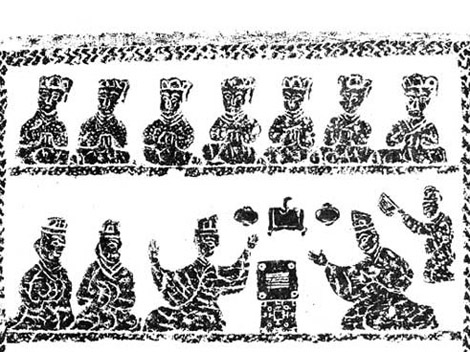
Source : Liubo (cultural China)
Provenance : Dongyan Village, Tongshan, Jiangsu. {34.178°N 117.057°E}
Current Location : Unknown.
Date : Eastern Han : Yuanhe 3 (86 CE).
Size : Unknown.
Notes : The four circles at the corners of the mat on which the six throwing sticks are lying may be intended to represent mat weights (cf. 4A.11, 4A.15, 4A.41 and 4A.44).
4A.11 Eastern Han picture stone from Jiangsu
江蘇徐州市銅山縣漢王鄉東沿村東漢元和三年墓出土畫像石
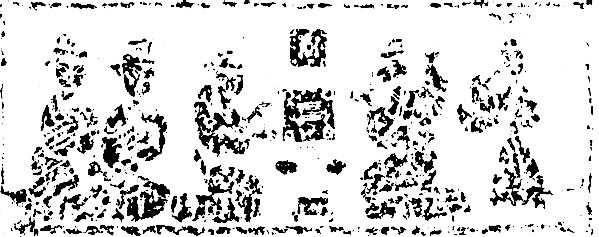
Source : Wenwu 文物 1990.9
Provenance : Dongyan Village, Tongshan, Jiangsu. {34.178°N 117.057°E}
Current Location : Unknown.
Date : Eastern Han : Yuanhe 3 (86 CE).
Size : Unknown.
4A.12 Han Dynasty picture stone from Shandong
山東出土漢代畫像石
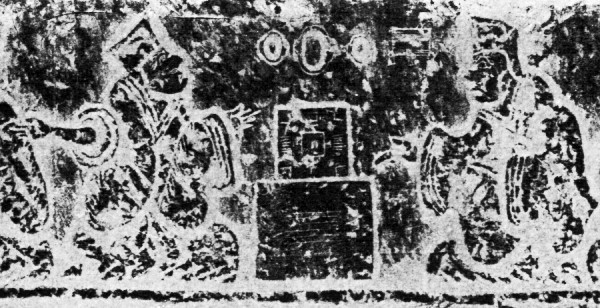
Source : Handai Huaxiang Quanji 漢代畫象全集 (Beijing, 1950–1951) vol.1 plate 253
Provenance : Shandong.
Current Location : Unknown.
Date : Han Dynasty (202 BCE – 220 CE).
Size : Unknown.
4A.13 Han Dynasty picture stone from Anhui
安徽出土漢代畫像石

Source : 戰事從來如弈棋—漢畫像石六博圖說 (漢畫像石與奧運)
Provenance : Anhui.
Current Location : Xuzhou Art Museum of Han Stone Gravings (徐州漢畫像石藝術館).
Date : Han Dynasty (202 BCE – 220 CE).
Size : Unknown.
Notes : The Queen Mother of the West (西王母) is in the left panel, and the King Father of the East (東王公) is in the right panel. See also A4.45 (also from Anhui), which has a very similar design.
4A.14 Han Dynasty picture stone
漢代畫像石

Source : 戰事從來如弈棋—漢畫像石六博圖說 (漢畫像石與奧運)
Provenance : Unknown.
Current Location : Xuzhou Art Museum of Han Stone Gravings (徐州漢畫像石藝術館).
Date : Han Dynasty (202 BCE – 220 CE).
Size : Unknown.
Notes : The Queen Mother of the West (西王母) is in the left panel, and the King Father of the East (東王公) is in the right panel.
4A.15 Han Dynasty picture stone
漢代畫像石
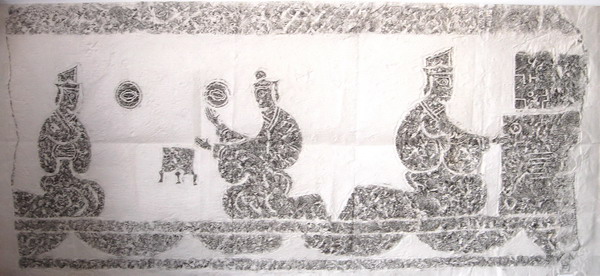
Source : 漢畫像石與奧運
Provenance : Unknown.
Current Location : Unknown.
Date : Han Dynasty (202 BCE – 220 CE).
Size : Unknown.
4A.16 Han Dynasty picture stone
漢代畫像石

Source : 樂舞百戲1 (CCTV)
Provenance : Unknown.
Current Location : Unknown.
Date : Han Dynasty (202 BCE – 220 CE).
Size : Unknown.
4A.17 Eastern Han picture stone from Shandong
山東嘉祥武榮祠出土東漢畫像石
Source : 畫像石講述生動歷史故事(二)
Source : Handai Huaxiang Quanji 漢代畫象全集 (Beijing, 1950–1951) vol.2 plate 177
Provenance : Wu Family Ancestral Temple, Jiaxiang, Shandong. {35.283°N 116.347°E}
Current Location : Unknown.
Date : Eastern Han (25 CE – 220 CE).
Size : Unknown.
4A.18 Western Han picture stone from Henan
河南唐河縣針織廠出土西漢畫像石
Source : Zhongguo Meishu Quanji 中國美術全集・繪畫編 (Shanghai, 1988) vol.18 plate 126
Provenance : Tanghe, Henan. {32.67°N 112.84°E}
Current Location : Nanyang Han Picture Gallery (南陽漢畫館).
Date : Western Han (202 BC – 9 CE).
Size : 64.0 × 138.0 cm.
Notes : The two figures in the foreground are playing Liubo; the larger square between them is the throwing mat, and the smaller square the Liubo board. A wine vessel is placed nearby, and in the background musicians and dancers entertain them. The figure on the front left is a servant attending to the needs of the Liubo players, who would appear to be persons of high status.
4A.19 Eastern Han picture stone from Shandong
山東微山兩城鎮出土東漢畫像石
Source : Zhongguo Meishu Quanji 中國美術全集・繪畫編 (Shanghai, 1988) vol.18 plate 34
Provenance : Liangcheng, Weishan, Shandong. {35.146°N 116.734°E}
Current Location : Qufu Cultural Relics Preservation Committee (曲阜縣文物管理委員會).
Date : Eastern Han (25 CE – 220 CE).
Size : 94.0 × 92.0 cm.
Notes : At the top of the picture is a panel showing four immortals riding mythological creatures. The top right of the main panel shows the Divine Healer Bian Que 扁鵲 (depicted in Han pictures as a bird with a human head) treating three sick people, and below this is a pair of humans playing Liubo, attended by a servant on the left. Most of the main panel is taken up by a waterside pavilion overlooking a lake that is full of fish, turtles and waterfowl. Two important-looking figures are seated in the pavilion, and seven people are watching from behind a guard rail. This picture is very similar to another one with no Liubo players:
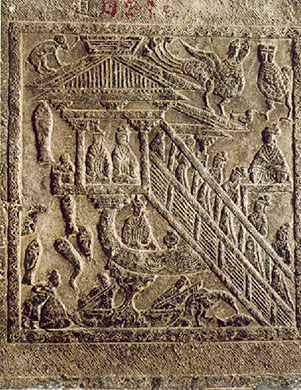
4A.20a Han Dynasty picture stone from Jiangsu
江蘇沛縣古泗水地區出土漢代畫像石
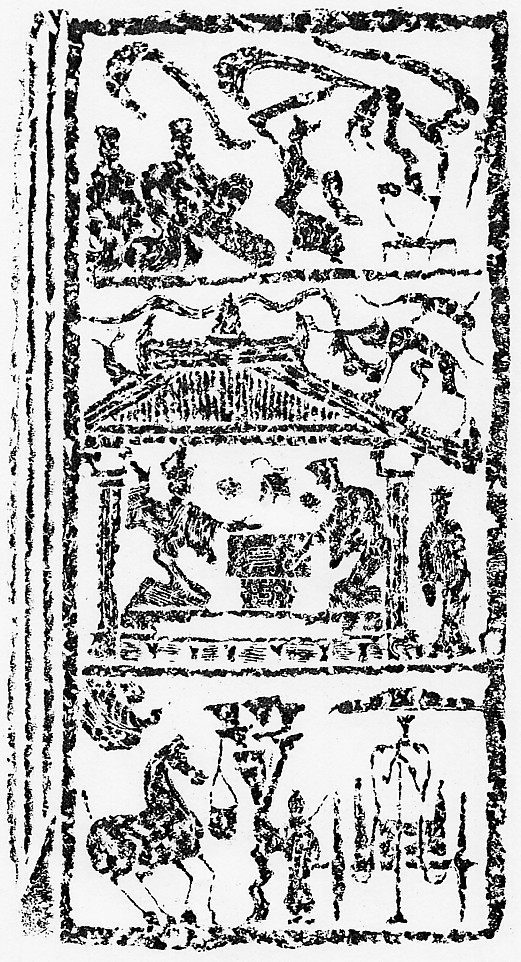
Source : Xuzhou Han Huaxiangshi 徐州漢畫象石 (Xuzhou, 1985) plate 232
[also Jiangsu Xuzhou Han Huaxiangshi 江蘇徐州漢畫象石 (Beijing, 1959) fig. 73]
[also 戰事從來如弈棋—漢畫像石六博圖說 (漢畫像石與奧運)]
Provenance : Pei County, Jiangsu. {34.735°N 116.930°E}
Current Location : Xuzhou Art Museum of Han Stone Gravings (徐州漢畫像石藝術館).
Date : Han Dynasty (202 BCE – 220 CE).
Size : 190.0 × 60.0 cm.
Notes : The player on the right appears to be placing or picking up a game piece or the throwing sticks, whilst the player on the left has one arm raised behind his back and the other arm stretched out in front, as if about to clap his hands together (in appreciation of a good play by his opponent?).
4A.20b Han Dynasty picture stone from Shandong
山東滕州微子墓出土漢代畫像石
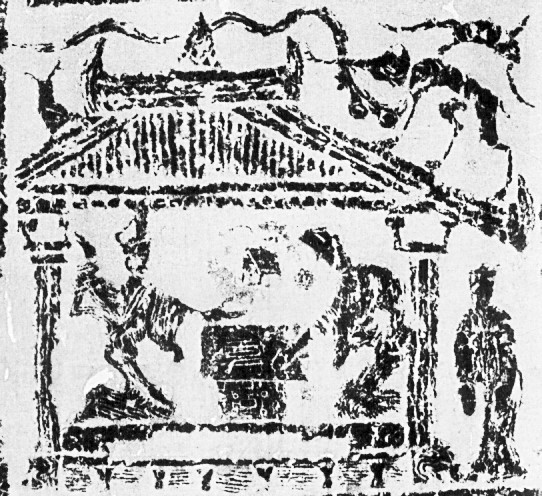
Source : Handai Huaxiang Quanji 漢代畫象全集 (Beijing, 1950–1951) vol.2 plate 62
Provenance : Weizimu, Tengzhou, Shandong. {34.662°N 117.225°E}
Current Location : Unknown.
Date : Han Dynasty (202 BCE – 220 CE).
Size : Unknown.
4A.21 Han Dynasty picture stone from Jiangsu
江蘇睢寧縣張圩出土漢代畫像石
Source : Xuzhou Han Huaxiangshi 徐州漢畫象石 (Xuzhou, 1985) plate 256
Provenance : Zhang Xu, Suining, Jiangsu. {33.999°N 117.971°E}
Current Location : Unknown.
Date : Han Dynasty (202 BCE – 220 CE).
Size : Unknown.
4A.22 Han Dynasty picture stone from Shandong
山東濟寧兩城山出土漢代畫像石
Source : Handai Huaxiang Quanji 漢代畫象全集 (Beijing, 1950–1951) vol.1 plate 43
Provenance : Liangcheng Shan, Jining, Shandong. {35.158°N 116.738°E}
Current Location : Unknown.
Date : Han Dynasty (202 BCE – 220 CE).
Size : Unknown.
4A.23 Han Dynasty picture stone from Shandong
山東出土漢代畫像石
Source : Handai Huaxiang Quanji 漢代畫象全集 (Beijing, 1950–1951) vol.1 plate 236
Provenance : Shandong.
Current Location : Unknown.
Date : Han Dynasty (202 BCE – 220 CE).
Size : Unknown.
Notes : Fabulous animals such as dragons and phoenixes are almost always shown on the roofs of pavilions, but these would seem to be purely decorative motifs put in to fill up otherwise empty space.
4A.45 Eastern Han picture stone from Jiangsu
江蘇徐州市附近出土漢代畫像石
Source : Wenwu 文物 2007.2 page 88 fig. 19
Provenance : Near Xuzhou, Jiangsu province.
Current Location : Xuzhou Art Museum of Han Stone Gravings (徐州漢畫像石藝術館)
Date : Eastern Han (25 CE – 220 CE).
Size : 93.0 × 120.0 cm.
Notes : Similar in design to 4A.20, with the players in the same postures.
4A.25 Han Dynasty picture stone
漢代畫像石
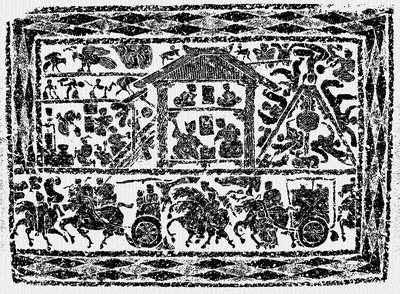
Source : 漢畫像石與奧運
Provenance : Unknown.
Current Location : Unknown.
Date : Han Dynasty (202 BCE – 220 CE).
Size : Unknown.
4A.26 Han Dynasty picture stone
漢代畫像石
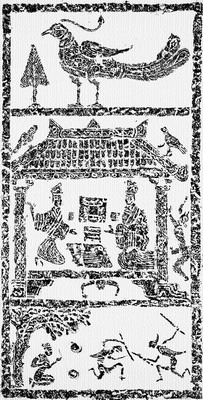
Source : 漢畫像石與奧運
Provenance : Unknown.
Current Location : Unknown.
Date : Han Dynasty (202 BCE – 220 CE).
Size : Unknown.
4A.27 Han Dynasty picture stone
漢代畫像石
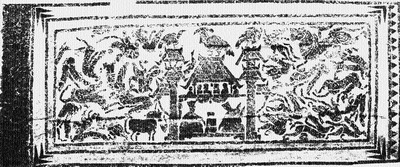
Source : 戰事從來如弈棋—漢畫像石六博圖說 (漢畫像石與奧運)
Provenance : Unknown.
Current Location : Xuzhou Art Museum of Han Stone Gravings (徐州漢畫像石藝術館).
Date : Han Dynasty (202 BCE – 220 CE).
Size : Unknown.
Notes : The Queen Mother of the West (西王母) is in the left panel, and the King Father of the East (東王公) is in the right panel.
4A.28 Han Dynasty picture stone from Jiangsu
江蘇徐州出土漢代畫像石
Source : 漢畫像 – 秋胡戲妻
Provenance : Xuzhou, Jiangsu.
Current Location : In a private collection.
Date : Han Dynasty (202 BCE – 220 CE).
Size : 6.8 × 5.2 cm.
4A.29 Han Dynasty picture stone from Jiangsu
江蘇徐州市銅山縣出土漢代畫像石
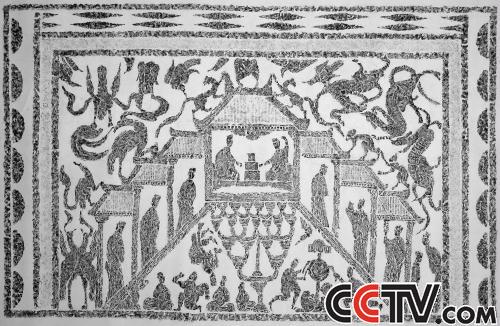
Source : 建築人物2 (CCTV)
Provenance : Tongshan, Jiangsu. {34.181°N 117.173°E}
Current Location : Beidongshan Han Picture Exhibition Hall (北洞山漢畫陳列館).
Date : Han Dynasty (202 BCE – 220 CE).
Size : Unknown.
4A.30 Han Dynasty picture stone from Jiangsu
江蘇徐州市東甸子漢墓出土畫像石

Source : Xuzhou Han Huaxiangshi 徐州漢畫象石 (Xuzhou, 1985) plate 31
Provenance : Dongdianzi, Xuzhou, Jiangsu. {34.265,°N 117.255°E}
Current Location : Unknown.
Date : Han Dynasty (202 BCE – 220 CE).
Size : Unknown.
4A.31 Eastern Han picture stone from Jiangsu
江蘇沛縣棲山東漢墓出土畫像石
Source : Xuzhou Han Huaxiangshi 徐州漢畫象石 (Xuzhou, 1985) plate 13
Provenance : Qishan, Pei County, Jiangsu. {34.623°N 116.811°E}
Current Location : Unknown.
Date : Eastern Han (25 CE – 220 CE).
Size : Unknown.
Notes : Two people are playing Liubo upstairs, the player on the left leaning foward as if placing or picking up a piece,and the player on the right with one arm raised behind his back and the other arm stretched forward in front of him. Curiously, on the wall behind the players is something that looks like a Liubo board design, although it cannot be the actual game board as that is the small rectangle between the players.
4A.32 Han Dynasty picture stone from Shandong
山東曲阜瓦窯頭村東安漢里出土漢代畫像石
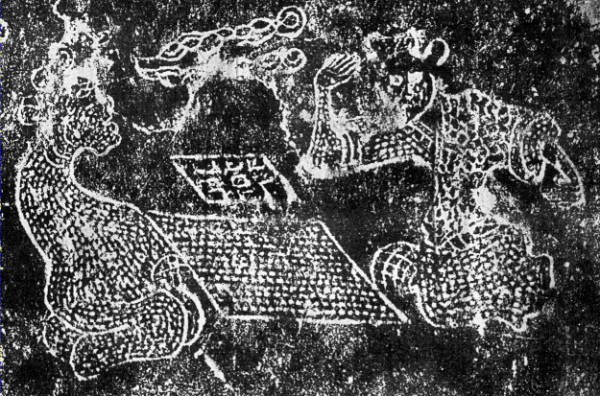
Source : Handai Huaxiang Quanji 漢代畫象全集 (Beijing, 1950–1951) vol.1 plates 57 and 59
[also Zhongguo Meishu Quanji 中國美術全集・繪畫編 (Shanghai, 1988) vol.18 plate 50]
Provenance : Wayaotou Village, Qufu, Shandong. {35.615°N 117.065°E}
Current Location : Qufu Cultural Relics Preservation Committee (曲阜縣文物管理委員會).
Date : Han Dynasty (202 BCE – 220 CE).
Size : Unknown.
4A.33 Han Dynasty picture stone from Shandong
山東曲阜瓦窯頭村東安漢里出土漢代畫像石
Source : Handai Huaxiang Quanji 漢代畫象全集 (Beijing, 1950–1951) vol.1 plate 60
Provenance : Wayaotou Village, Qufu, Shandong. {35.615°N 117.065°E}
Current Location : Unknown.
Date : Han Dynasty (202 BCE – 220 CE).
Size : Unknown.
4A.34 Eastern Han picture stone from Shandong
山東鄒城高李村東漢墓出土畫像石

Source : Wenwu 文物 1994.6 page 29
Provenance : Gaoli Village, Zoucheng, Shandong. {35.230°N 116.800°E}
Current Location : Unknown.
Date : Eastern Han (25 CE – 220 CE).
Size : 70.0 × 70.0 cm.
Notes : In the foreground two people are playing Liubo, and in the background two people are watching, with a servant standing on either side.
References : 《山東鄒城高李村漢畫像石墓》 (《文物》1994.6).
4A.35 Han Dynasty picture stone from Jiangsu
江蘇徐州市銅山縣出土漢代畫像石
Source : Xuzhou Han Huaxiangshi 徐州漢畫象石 (Xuzhou, 1985) plate 218
Provenance : Tongshan, Jiangsu. {34.181°N 117.173°E}
Current Location : Unknown.
Date : Han Dynasty (202 BCE – 220 CE).
Size : Unknown.
4A.36 Eastern Han picture stone from Jiangsu
江蘇邳縣白山故子2號東漢墓出土畫像石
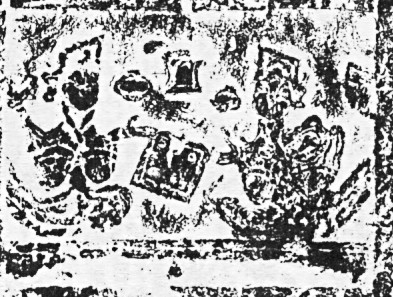
Source : Wenwu 文物 1986.5
Provenance : Baishan guzi, Pi County, Jiangsu. {34.12°N 117.88°E}
Current Location : Unknown.
Date : Eastern Han (25 CE – 220 CE).
Size : Unknown.
江苏邳县白山故子
4A.37 Han Dynasty picture stone from Jiangsu
江蘇睢寧縣張圩出土漢代畫像石
Source : Xuzhou Han Huaxiangshi 徐州漢畫象石 (Xuzhou, 1985) plate 249
Provenance : Zhang Xu, Suining, Jiangsu. {33.999°N 117.971°E}
Current Location : Unknown.
Date : Han Dynasty (202 BCE – 220 CE).
Size : Unknown.
4A.38 Han Dynasty picture stone from Jiangsu
江蘇徐州市銅山縣臺上村出土漢代畫像石
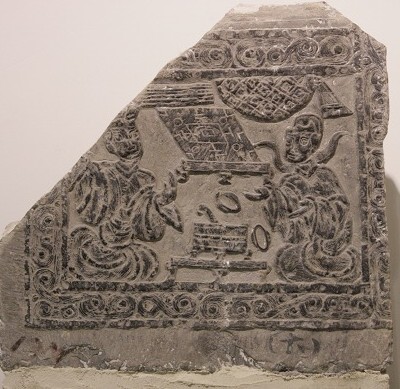
Source : 徐(下)從獅子山到雲龍山
Source : Xuzhou Han Huaxiangshi 徐州漢畫象石 (Xuzhou, 1985) plate 178
Provenance : Taishang Village, Tongshan, Jiangsu. {34.138°N 117.131°E}
Current Location : Xuzhou Art Museum of Han Stone Gravings (徐州漢畫像石藝術館).
Date : Han Dynasty (202 BCE – 220 CE).
Size : Unknown.
Notes : In this picture the players appear to be taking a rest from the game, as the six throwing sticks are lined up out of reach on the far side of the Liubo board, and the wine bowl and two lacquer wine cups have been put directly between the players. The players hands are stretched out as if gesturing animatedly, perhaps arguing other the result of the game they have just finished playing. Unusually, the design of the Liubo board included a square within the central square.
4A.39 Han Dynasty picture brick from Sichuan
四川新津堡字山出土漢代畫像磚
Source : Sichuan Handai Huaxiang Xuanji 四川漢代畫象選集 (Shanghai, 1955) fig. 79
[also Sichuan Handai Huaxiangzhuan 四川漢代畫像磚 (Shanghai, 1987) fig. 34]
[also Zhongguo Gudaishi Cankao Tulu: Qian-Han Shiqi 中國古代史參考圖錄・秦漢時期 (Shanghai, 1990) page 233]
Provenance : Baozi Shan, Xinjin, Sichuan. {30.402°N 103.818°E}
Current Location : Unknown.
Date : Han Dynasty (202 BCE – 220 CE).
Size : Unknown.
4A.40a Han Dynasty picture brick from Sichuan
四川成都市郊出土漢代畫像磚
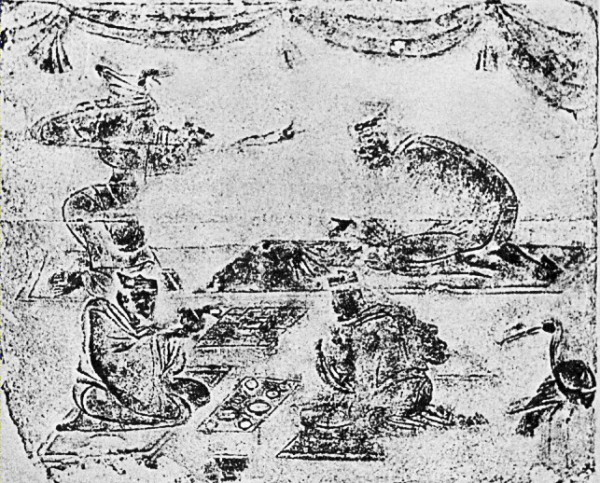
Source : Sichuan Handai Huaxiangzhuan 四川漢代畫像磚 (Shanghai, 1987) fig. 36
Provenance : Chengdu, Sichuan.
Current Location : Unknown.
Date : Han Dynasty (202 BCE – 220 CE).
Size : Unknown.
4A.40b Han Dynasty picture brick from Sichuan
四川成都出土漢代畫像磚
Source : Chongqingshi Bowuguan Cang Sichuan Han Huaxiangzhuan Xuanji 重慶市博物館藏四川漢畫像磚選集 (Beijing, 1957) fig. 11
Provenance : Chengdu, Sichuan. {30.65°N 104.05°E}
Current Location : Unknown.
Date : Han Dynasty (202 BCE – 220 CE).
Size : Unknown.
4A.41 Han Dynasty picture stone from Sichuan
四川新津出土漢代畫像石
Source : Sichuan Handai Diaosu Yishu 四川漢代彫塑藝術 (Beijing, 1959) fig. 46
[also Sichuan Handai Huaxiang Xuanji 四川漢代畫象選集 (Shanghai, 1955) fig. 48]
Provenance : Xinjin, Sichuan. {30.40°N 103.80°E}
Current Location : Unknown.
Date : Han Dynasty (202 BCE – 220 CE).
Size : Unknown.
4A.42 Eastern Han picture brick from Hubei
湖北當陽半月一號東漢墓出土畫像磚
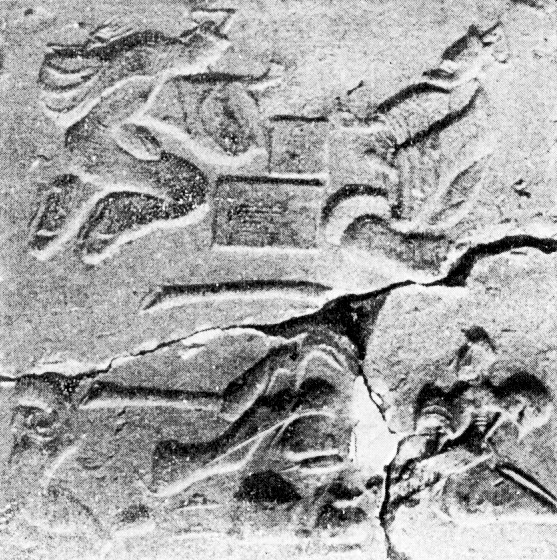
Source : Wenwu 文物 1991.12
Provenance : Banyue, Dangyang, Hubei. {30.616°N 111.838°E}
Current Location : Unknown.
Date : Eastern Han (25 CE – 220 CE).
Size : Unknown.
4A.43 Han Dynasty picture stone
漢代畫像石
Source : 漢畫像石與奧運
Provenance : Unknown.
Current Location : Unknown.
Date : Han Dynasty (202 BCE – 220 CE).
Size : Unknown.
4A.44 Eastern Han picture stone from Shaanxi
陝西綏德四十鋪鎮出土東漢畫像石
Source : Zhongguo Meishu Quanji 中國美術全集・繪畫編 (Shanghai, 1988) vol.18 plate 78
Provenance : Sishipu Zhen, Suide, Shaanxi. {37.625°N 110.230°E}
Current Location : Suide County Museum (綏德縣博物館).
Date : Eastern Han (25 CE – 220 CE).
Size : 97.0 × 30.0 cm.
Notes : Engraving on the inner left side of a tomb gateway, showing pairs of men drinking, dancing, and playing Liubo and other games. The six throwing sticks are lined up on a mat between the players (the four circles at the corners of the mat may be intended to represent mat weights), but the players' hands are raised with fingers outstretched as if playing some sort of hand game. Perhaps this was to decide who would throw first.
4A.45 Eastern Han picture stone from Anhui
安徽蕭縣出土漢代畫像石

Source : Wenwu 文物 2010.6 page 61
Provenance : Xiao County, Anhui. {34.180°N 116.950°E}
Current Location : Unknown.
Date : Eastern Han (25 CE – 220 CE).
Size : 248.0 × 46.0 cm.
Notes : This picture stone was located on the lintel of the southern wall of the antechamber of tomb M1. Its design is very similar to 4A.13, which also comes from Anhui, although in this picture the Queen Mother of the West (西王母) is in the right panel and the King Father of the East (東王公) is in the left panel. It is interesting to note that the player and observers on the left are seated on the floor, whereas the player and observers on the right are seated on a raised platform, suggesting a difference in status between the two players.
References : 《安徽蕭縣新出土的漢代畫像石》 (《文物》2010.6).
Last updated: 2014-11-29.
Index of BabelStone Blog Posts

